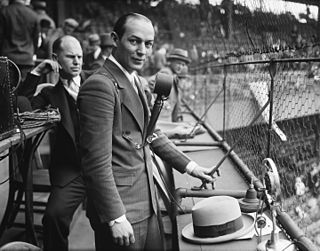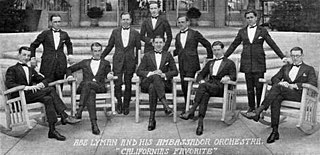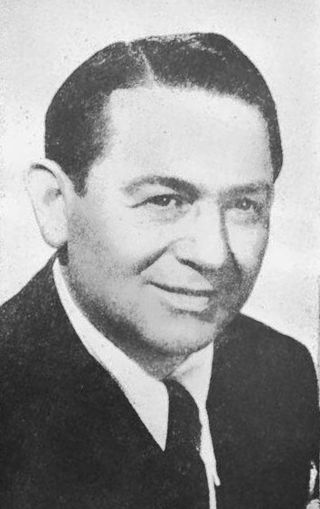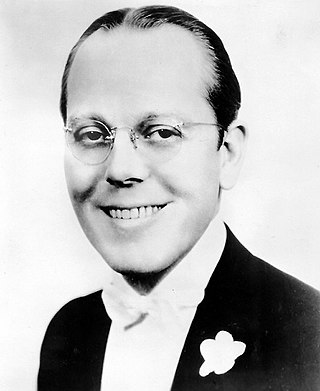The Oldsmobile Show is a half-hour weekly old-time radio variety program in the United States. It was broadcast on CBS in 1933 [1] and 1934. [2]
The Oldsmobile Show is a half-hour weekly old-time radio variety program in the United States. It was broadcast on CBS in 1933 [1] and 1934. [2]
The Oldsmobile Program featured "Ted Husing's sport talks" and music. [3]
Ted Husing was the program's host. The Encyclopedia of American Radio, 1920-1960, 2nd Edition says that Leon Belasco's orchestra provided the music, with contralto Barbara Mauel as soloist and the Hummingbirds as the vocal group. [1] The April 1933 issue of Radio News indicates that George Olsen and his orchestra were the musicians for the program, with Ethel Shutta, Fran Frey and Richard Gardner singing and that Gus Van was "continuing the comedy and character songs which were identified with the Van and Schenck stage partnership of twenty years. [4]
In 1934, Husing continued as the host, with Ruth Etting as soloist, backed by Johnny Green and his orchestra. [2]

Edward Britt Husing was an American sportscaster. He was among the first to lay the groundwork for the structure and pace of modern sports reporting on television and radio.

Wilfred Theodore Wemyes, known professionally as Ted Weems, was an American bandleader and musician. Weems's work in music was recognized with a star on the Hollywood Walk of Fame.
The Voice of Firestone was a radio and television program of classical music. The show featured leading singers in selections from opera and operetta. Originally titled The Firestone Hour, it was first broadcast on the NBC Radio network on December 3, 1928 and was later also shown on television starting in 1949. The program was last broadcast in 1963.

William Edward Maguiness was the host of Ted Mack and The Original Amateur Hour on radio and television.

George Edward Olsen Sr. was an American bandleader.

Benjamin Anzelwitz, known professionally as Ben Bernie, was an American jazz violinist, bandleader, and radio personality, often introduced as "The Old Maestro". He was noted for his showmanship and memorable bits of snappy dialogue, being part of the first generation of "stars" of American popular music, alongside other artists such as Paul Whiteman, Ted Lewis and Al Jolson.

The Major Bowes Amateur Hour was an American radio talent show broadcast in the 1930s and 1940s, created and hosted by Edward Bowes (1874–1946). Selected performers from the program participated in touring vaudeville performances, under the "Major Bowes" name. The program later transitioned to television under host Ted Mack.

Accordiana was a musical radio series which was heard on CBS in 1934, airing at 8:30 p.m. on Tuesday evenings. The 30-minute program featured soprano Vivienne Segal and tenor Oliver Smith. They were accompanied by the Abe Lyman Orchestra, and the show was sometimes given in newspaper radio listings as Abe Lyman's Accordiana. Peter Dixon, in his syndicated column "Inside the Studios," reported in 1934 that Lyman directed his orchestra from the control booth instead of standing in front of the musicians.
The year 1933 saw a number of significant events in radio broadcasting.

Jan Garber was an American violinist and jazz bandleader.

The Ford Sunday Evening Hour is an American concert radio series sponsored by the Ford Motor Company. The hour-long program was broadcast from 1934 to 1946, with a hiatus from 1942 to 1945. Later known as The Ford Symphony Hour, the program presented selections of classical music, hymns, popular ballads and well-known arias.

Frank Parker was an American singer and radio and television personality.
Fran Frey was a singer and saxophonist best known for his work for George Olsen and His Music in the 1920s and early 1930s. Among his better known songs are "The Varsity Drag" of 1927; "Big City Blues" of 1929, and "A Garden in the Rain", also of 1929. Frey sang on 77 songs with the George Olsen band on recordings and on the radio. "Who?" sold more than a million copies.

Don Bestor was an American bandleader, probably best known for directing the orchestra in the early years of The Jack Benny Program on old-time radio.

The March of Time is an American radio news documentary and dramatization series sponsored by Time Inc. and broadcast from 1931 to 1945. Created by broadcasting pioneer Fred Smith and Time magazine executive Roy E. Larsen, the program combined actual news events with reenactments. The "voice" of The March of Time was Westbrook Van Voorhis. The radio series was the basis of the famed March of Time newsreel series shown in movie theaters from 1935 to 1951.

Elizabeth Irene Beasley, known as the "long, tall gal from Dixie," was a singer and master of ceremonies best known for her work on old-time radio.

Ted Steele was an American bandleader and host of several radio and television programs. He also held administrative positions at radio stations and had his own media-related businesses.
Nestle Chocolateers is an old-time radio musical program in the United States. It was broadcast on NBC-Blue in the early 1930s. The name is often found in publications as Nestle's Chocolateers. The 30-minute program's title came from its sponsorship by the Nestle Chocolate Company. It debuted September 5, 1930.

Blackstone Plantation is an old-time radio musical variety program in the United States. It was broadcast on CBS (1929–1930) and on NBC (1930–1934). The program was one of NBC's top-rated programs in 1932.